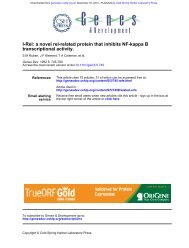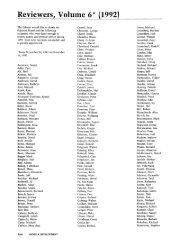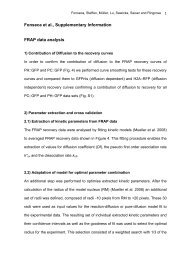Pancreatic cancers require autophagy for tumor growth - Genes ...
Pancreatic cancers require autophagy for tumor growth - Genes ...
Pancreatic cancers require autophagy for tumor growth - Genes ...
You also want an ePaper? Increase the reach of your titles
YUMPU automatically turns print PDFs into web optimized ePapers that Google loves.
Downloaded from<br />
genesdev.cshlp.org on June 4, 2013 - Published by Cold Spring Harbor Laboratory Press<br />
Figure 7. PDAC metabolism is altered by<br />
<strong>autophagy</strong> inhibition. (A) Oxidative phosphorylation,<br />
as measured by oxygen consumption<br />
in 8988T PDAC cells. (Blue)<br />
Control; (red) CQ. CQ treatment robustly<br />
decreases the basal oxygen consumption<br />
ratio (OCR), normalized to cell number or<br />
protein concentration. Data represent the<br />
mean of four independent experiments,<br />
with error bars representing standard deviations.<br />
The graph shows basal mitochondrial<br />
respiration (3 mM glucose) (arrow) and<br />
leak (respiration nonlinked to mitochondrial<br />
ATP synthesis, 2 mM oligomycin) (line<br />
A), nonmitochondrial OCR (2 mM antimycin<br />
A) (line C) and respiration after<br />
FCCP (5 mM) (line B). Identical experiments<br />
as in A were per<strong>for</strong>med using two shRNAs<br />
to ATG5 (HP2 and HP7). Both shRNAs<br />
decrease basal oxygen consumption similar<br />
to CQ. Data represent the mean of three<br />
independent experiments. (C) 8988T cells<br />
were treated with CQ, and glucose uptake<br />
was measured and compared with control<br />
cells (left panel) and lactate secretion (right panel). Note the significant increase in glucose uptake as well as increased lactate secretion<br />
in cells in which <strong>autophagy</strong> is inhibited by CQ, indicating an increase in glycolysis. (Asterisk shows a statistically significant change by<br />
t-test.) (D) Inhibition of <strong>autophagy</strong> results in a decrease in intracellular ATP. Results are expressed as a fold of control and are<br />
normalized to protein concentration. Data are from three independent experiments, with error bars representing standard deviations.<br />
The asterisk shows a statistically significant decrease compared with control by a t-test. (E) Autophagy inhibition does not result in an<br />
increase in mitochondrial mass. Western blotting <strong>for</strong> TOM20 or Porin (mitochondrial proteins) does not show increases upon inhibition<br />
of lysosomal proteases plus CQ <strong>for</strong> the indicated time periods. Mitochondrial mass was also determined by quantitative real-time PCR<br />
using two different primers <strong>for</strong> mitochondrial DNA (a and b). Data shown are from two independent experiments per<strong>for</strong>med in<br />
triplicate. Expression was normalized using primers <strong>for</strong> nuclear-derived DNA and expressed as fold of control. There was no significant<br />
increase in mitochondrial mass in response to CQ treatment. (F) Mitochondrial membrane potential was measured using JC1. The<br />
uncoupler CCCP was included as a positive control <strong>for</strong> depolarized mitochondria. The top panel shows a representative experiment<br />
showing no increase in mitochondrial membrane depolarization upon CQ treatment. The graph below shows data from two independent<br />
experiments. (G) The addition of methyl pyruvate (MP) protects PDAC cells from <strong>autophagy</strong> inhibition by CQ. 8988T cells were treated<br />
with the indicated concentration of MP and subjected to IC50 assays with increasing doses of CQ. As depicted in the bar graph, the IC50s<br />
markedly increase with increasing concentrations of MP, indicating that it is protecting cells from the inhibitory effects of CQ.<br />
near-normal immortalized HPDE cells were reported previously<br />
(Furukawa et al. 1996; Liu et al. 1998). Typically, Lipofectamine<br />
2000 (Invitrogen, 11668) was used to transfect cells with plasmids,<br />
and RNAiMax (Invitrogen, 13778) was used <strong>for</strong> siRNAs.<br />
All siRNAs were used at a final concentration of 20 nM.<br />
Plasmids and RNAi<br />
pBabe-LC3-GFP was constructed by subcloning EGFP-LC3 from<br />
EGFP-LC3 (Addgene, 11546) into pBabe-puro. 53BP1-GFP fusion<br />
plasmid was a generous gift from Randall King (Harvard School of<br />
Public Health). The GFP-Neo construct has been described previously<br />
(Nimmerjahn et al. 2003). The Rab7 dominant-negative<br />
(T22N) was a generous gift from Dr. Andrew Thorburn (University<br />
of Colorado Cancer Center). ATG5 and Lamp2 siRNAs were<br />
synthesized by Invitrogen: ATG5: siA, CAAUCCCAUCCAGA<br />
GUUGCUUGUGA; siB, AGUGAACAUCUGAGCUACCCGG<br />
AUA. Lamp2: siA, UCAGGAUAAGGUUGCUUCAGUUAUU;<br />
siB, GCAGCACCAUUAAGUAUCUAGACUU. ATG5 shRNAs<br />
were a generous gift from Xiao-Feng Zhu (Zhou et al. 2009).<br />
Autophagy assays<br />
Long-term protein degradation monitoring using Neo-GFP has<br />
been described previously (Nimmerjahn et al. 2003). In brief,<br />
<strong>Pancreatic</strong> <strong>cancers</strong> <strong>require</strong> <strong>autophagy</strong><br />
cells were transfected with Neo-GFP using lipid-based transfection.<br />
Fresh medium containing the indicated drugs was added<br />
daily. At the specified time point, cells were trypsinized and<br />
fixed in 70% ethanol and stored at 4°C until the day of analysis.<br />
Fixed cells were washed twice with cold PBS twice and analyzed<br />
by FACS <strong>for</strong> GFP expression. Ten-thousand cells were analyzed<br />
in each experiment. Virus encoding EGFP-LC3 was packaged in<br />
293T cells and stable cell lines were created by standard infection<br />
protocols in the presence of polybrene and selected with puromycin<br />
<strong>for</strong> at least 2 d. To assess <strong>for</strong> <strong>autophagy</strong>, cells were plated<br />
on multitest slides, treated as indicated, and fixed with 4%<br />
para<strong>for</strong>maldehyde. Typically, at least 200 cells were counted, and<br />
cells with more than five puncta were considered <strong>autophagy</strong>positive.<br />
To determine the number of foci per cell, deconvolution<br />
images were taken using a Zeiss Axio Imager Z1 and a<br />
three-dimensional reconstruction was created. The total number<br />
of foci was counted in a minimum of 60 cells. To detect<br />
mitophagy, two different assays were used. First, cells were<br />
transfected with an mCherry-Parkin fusion protein and Parkin<br />
foci were scored. Alternatively, 8988T cells stably expressing<br />
LC3-GFP were treated with or without CQ (25 mM) <strong>for</strong> 4 h. Cells<br />
were fixed with 4% para<strong>for</strong>maldehyde, followed by immunofluorescence<br />
staining with antibody against TOM20 and Cy3conjugated<br />
secondary antibody. Deconvolution images were<br />
taken using a Zeiss Axio Imager Z1 to detect colocalization<br />
GENES & DEVELOPMENT 725







